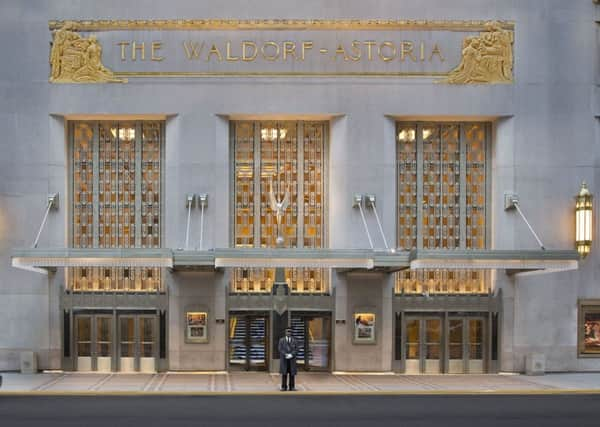Waldorf Astoria ‘undervalues Scottish bank notes’


The exchange rate board at the five-star Waldorf Astoria Hotel in New York was yesterday advertising $1.3387 for Scottish banknotes compared to $1.3429 for English currency.
Although the difference is marginal, financial experts said they were baffled as to why the two notes, which are worth exactly the same, would be valued at two separate rates.
Advertisement
Hide AdAdvertisement
Hide AdOne travel writer expressed surprise at the move by the five-star Waldorf, which created the eponymous salad and was once a temporary home for film star Marilyn Monroe.
A Hilton Worldwide spokesperson said: “As part of our commitment to delivering true Waldorf service, we offer our guests at the Waldorf Astoria New York the facility to exchange currency at their convenience. We base the exchange rates on those listed on New York based currency exchange company Choice Forex’s website and are not privy to the factors they consider when establishing these differing rates.”
Angus Campbell, a senior analyst at FxPro, a UK-based online broker, said he had never heard of different rates for the same currency.
He added: “It seems strange that something that has the same value in London and Edinburgh would be of different value in a New York hotel, just because of the colour of its notes.
“I’m speculating that there are obviously fewer Scottish notes in distribution and I should imagine that because they are not as widely recognised as English notes, then they are apportioning some sort of extra risk associated with taking them. ”
A spokesman for Choice Forex, a currency services firm based in New York’s Empire State Building, said: “They are the same currency and exactly the same value. But when we have excess Scottish or Northern Irish notes, we have to sell them off and the wholesalers pay us less.
“The notes are valued the same but there is a smaller market for them.”
The UK Treasury could not confirm this. A spokesman said: “There is no economic reason for currency dealers to offer a different exchange between two interchangeable notes”.
Travel writer Kate Wickers said it was unacceptable.
Advertisement
Hide AdAdvertisement
Hide AdShe added: “It is my understanding that the US, like many other countries, does not consider Scottish banknotes to be as easily convertible to cash, therefore does not want the extra hassle of dealing with them. So they sometimes levy extra charges for the bother, or in this case offer an unfair rate so that it puts people off. If it were a small business, I have some sympathy but, with a hotel like the Waldorf Astoria, I’m surprised.”
Stewart Hosie, the SNP Treasury spokesman, said the move by the hotel was “very unfair” on visiting Scots. He said: “This is a situation which Scottish holidaymakers to various parts of the world will sadly have experienced for themselves.”
It is not the first time this currency discrepancy has been flagged up. In 2008, it was reported that bureaux de change in Prague were valuing Scottish ten-pound notes at £1.50 less than English ones.
Also in 2001, it was reported holiday company Thomas Cook admitted that it charged different rates for Scottish and English notes at money-changing centres across the US.
Waldorf Astoria: Host to famous names and part of the cultural landscape
A LUXURY hotel in New York’s exclusive Park Avenue in Manhattan, the Waldorf Astoria is a world-famous part of the city’s physical and cultural landscape.
Though it has sat in its current location since 1931, it was originally opened in 1893 on the same Fifth Avenue site that the Empire State Building now occupies.
With 1,508 rooms, it was the first hotel to offer room service, making a huge impact on the hotel industry.
Advertisement
Hide AdAdvertisement
Hide AdIt has its own railway platform as part of Grand Central Terminal – which is accessed via a lift which transported the former US president Franklin D Roosevelt.
Nowadays it also houses a boutique “hotel within a hotel” on the upper floors, known as The Waldorf Towers. It is, of course, the home of the Waldorf salad.
During the 20th century, it played host to some of the biggest names in American culture and politics – former president Herbert Hoover, retired General Douglas MacArthur, gangsters Benjamin “Bugsy” Siegel and Charles “Lucky” Luciano. Song writer Cole Porter and Marilyn Monroe spent extended periods there.
CRAIG BROWN